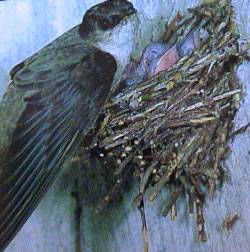Chimney Swifts
Written by: Nick Lardinois
As I sit at my desk on a rainy morning at the Woodland Dunes headquarters, I can hear a faint squeaking in the wall in front of me. No, the noise is not from mice, but chimney swifts. These small birds have special saliva that has a sticky component, allowing them to glue small twigs together in a half-saucer shape against a vertical surface. Most nesting cavities must occur in spaces almost a foot wide and anywhere from 1-16 feet deep. In the past, chimney swifts have traditionally nested in old-growth forests where tall, hollow trees were abundant. However, due to extensive human development, many of these natural homes for chimney swifts were replaced with man-made structures. Luckily for the bird, millions of buildings were coincidentally constructed with a suitable nesting place: chimneys.
Brick chimneys suit this species best. Oddly enough, chimney swifts cannot perch like most birds. Instead, their feet are specially adapted to cling to vertical spaces. Rough, adhesive surfaces such as brick are exceptional material for resting as well as a place to stick their nests. Unfortunately, brick chimneys are becoming a staple of the past as metal, plastic, and composite are structures are becoming more common. Additionally, traditional nesting sites, such as old buildings like the Hamilton building in downtown Two Rivers, are more frequently being destroyed. The result is a significant decline, up to 65%, in chimney swift populations nationwide. What was once a common bird is now listed as ‘Near Threatened’ by the International Union for Conservation of Nature.
 Why should we care about the demise of the chimney swift? To begin, this acrobatic bird is one of the nature’s pest control champions. A pair of nesting adults with three young consume the equivalent of 6000 insects per day. As a result of their long, narrow bodies and impressive flying abilities, these birds are frequently mistaken as bats foraging the night sky. Flying upwards of 35 miles per hour with frequent changes in direction, the chimney swift snatches up to one third of their own body weight in flying insects each day. At a weight around one ounce per bird, and roosts nearing 3000 birds in Wisconsin, a community of chimney swifts can eat up to 60 pounds of insects in a single day! These birds are also fun to watch. Shortly after sunset, the birds return to their cavities, often pouring into chimneys in groups so thick they resemble a tornado of smoke.
Why should we care about the demise of the chimney swift? To begin, this acrobatic bird is one of the nature’s pest control champions. A pair of nesting adults with three young consume the equivalent of 6000 insects per day. As a result of their long, narrow bodies and impressive flying abilities, these birds are frequently mistaken as bats foraging the night sky. Flying upwards of 35 miles per hour with frequent changes in direction, the chimney swift snatches up to one third of their own body weight in flying insects each day. At a weight around one ounce per bird, and roosts nearing 3000 birds in Wisconsin, a community of chimney swifts can eat up to 60 pounds of insects in a single day! These birds are also fun to watch. Shortly after sunset, the birds return to their cavities, often pouring into chimneys in groups so thick they resemble a tornado of smoke.
More importantly, the chimney swift can serve as another case for why reconciliation ecology is of the utmost importance. Reconciliation ecology is an emerging field that diverts from the idea that nature and society are separate entities. This branch of ecology recognizes that in order to protect and maintain nature, we must incorporate it within our human landscapes. As development increases and natural environments decrease, there is a growing need for synchronizing the nurturing of biodiversity and human benefit. Not only does reconciliation ecology help wild species, but research shows an increase in human-environment intimacy can decrease stress and improve productivity.
As the story of the chimney swift goes, we must recognize our actions have an impact on surrounding species. By converting old-growth forests to urban landscapes dotted with brick chimneys, we replaced their natural habitat with a viable alternative. Now, with the demise of our replacements, this valuable bird is struggling to persist. As Antoine de Saint-Exupéry wrote in The Little Prince, “You become responsible, forever, for what you have tamed.” Humans have the unique ability to consciously destroy, to tame, the natural world for personal benefit. With this ability comes a unique responsibility to consequently protect the natural world for future generations. Reconciliation ecology challenges the notion that our development cannot simultaneously promote the environment. Thinking of the chimney swift, we once provided alternative housing for the birds when we took away their previous homes in the forests. Hopefully we can help reverse the decline of this species through thoughtful, conservatory actions now that we are removing their homes once again.
